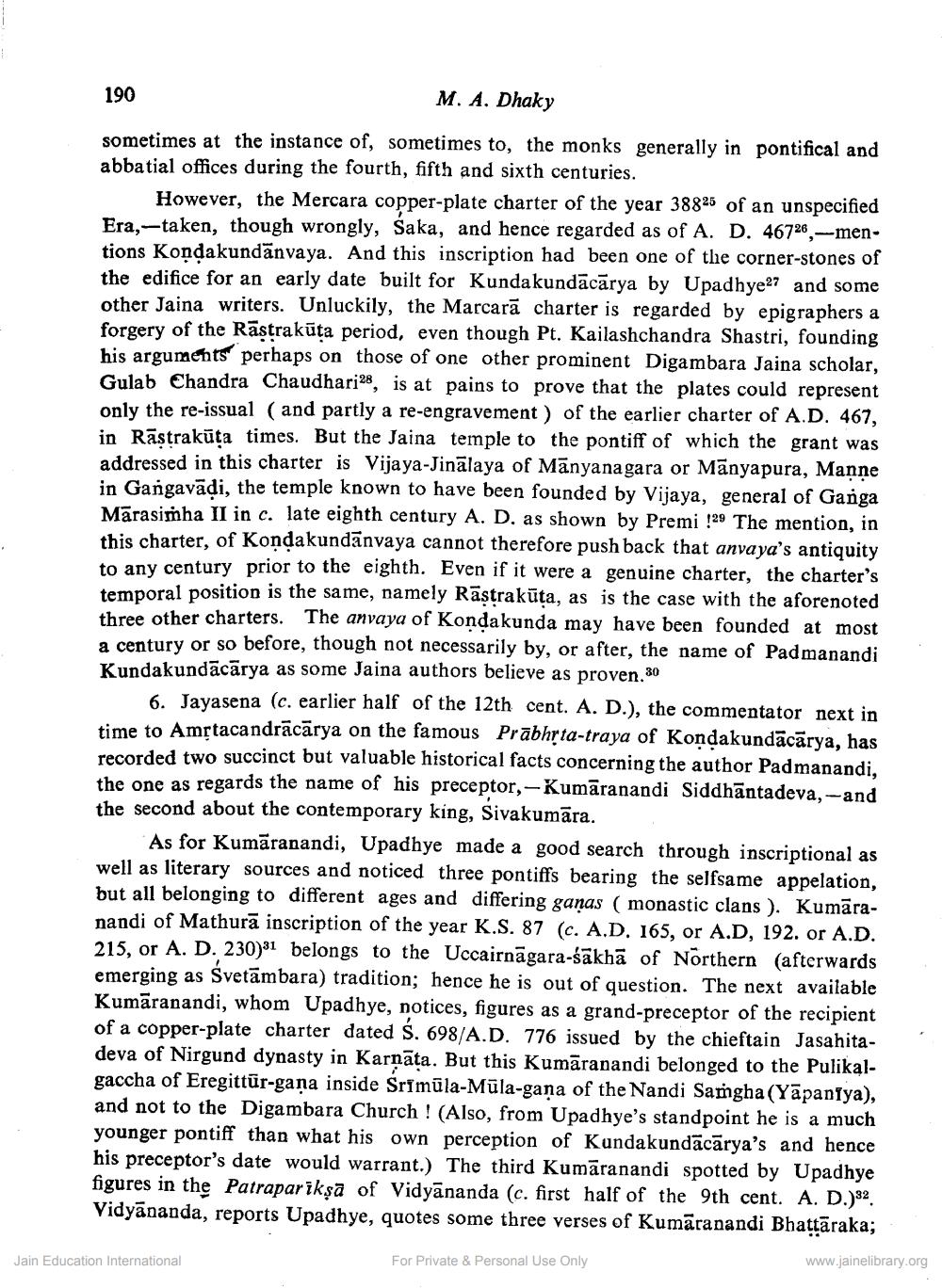Book Title: Date of Kundakundacharya Author(s): M A Dhaky Publisher: Z_Aspect_of_Jainology_Part_3_Pundit_Dalsukh_Malvaniya_012017.pdf View full book textPage 4
________________ 190 M. A. Dhaky sometimes at the instance of, sometimes to, the monks generally in pontifical and abbatial offices during the fourth, fifth and sixth centuries. However, the Mercara copper-plate charter of the year 38825 of an unspecified Era,--taken, though wrongly, Saka, and hence regarded as of A. D. 46726, ---mentions Kondakundānvaya. And this inscription had been one of the corner-stones of the edifice for an early date built for Kundakundācārya by Upadhye27 and some other Jaina writers. Unluckily, the Marcarā charter is regarded by epigraphers a forgery of the Rāstrakūta period, even though Pt. Kailashchandra Shastri, founding his arguments perhaps on those of one other prominent Digambara Jaina scholar, Gulab Chandra Chaudhari28, is at pains to prove that the plates could represent only the re-issual (and partly a re-engravement) of the earlier charter of A.D. 467, in Rāstrakūta times. But the Jaina temple to the pontiff of which the grant was addressed in this charter is Vijaya-Jinalaya of Manyanagara or Manyapura, Manne in Gangavādi, the temple known to have been founded by Vijaya, general of Ganga Mārasimha II in c. late eighth century A. D. as shown by Premi !29 The mention, in this charter, of Kondakundānvaya cannot therefore push back that anvaya's antiquity to any century prior to the eighth. Even if it were a genuine charter, the charter's temporal position is the same, namely Rāstraküta, as is the case with the aforenoted three other charters. The anvaya of Kondakunda may have been founded at most a century or so before, though not necessarily by, or after, the name of Padmanandi Kundakundācārya as some Jaina authors believe as proven.30 6. Jayasena (e. earlier half of the 12th cent. A. D.), the commentator next in time to Amstacandrācārya on the famous Prābhrta-traya of Kondakundācārya, has recorded two succinct but valuable historical facts concerning the author Padmanandi, the one as regards the name of his preceptor,-Kumāranandi Siddhāntadeva,-and the second about the contemporary king, Sivakumāra. As for Kumāranandi, Upadhye made a good search through inscriptional as well as literary sources and noticed three pontiffs bearing the selfsame appelation, but all belonging to different ages and differing ganas ( monastic clans ). Kumāranandi of Mathurā inscription of the year K.S. 87 (c. A.D. 165, or A.D, 192. or A.D. 215, or A. D. 230)31 belongs to the Uccairnāgara-sakhā of Northern (afterwards emerging as Svetāmbara) tradition; hence he is out of question. The next available Kumāranandi, whom Upadhye, notices, figures as a grand-preceptor of the recipient of a copper-plate charter dated S. 698/A.D. 776 issued by the chieftain Jasahitadeva of Nirgund dynasty in Karnata. But this Kumāranandi belonged to the Pulikalgaccha of Eregittūr-gana inside Srimūla-Müla-gana of the Nandi Samgha (Yāpaniya), and not to the Digambara Church ! (Also, from Upadhye's standpoint he is a much younger pontiff than what his own perception of Kundakundācārya's and hence his preceptor's date would warrant.) The third Kumāranandi spotted by Upadhye figures in the Patraparikșa of Vidyānanda (c. first half of the 9th cent. A. D.)32. Vidyānanda, reports Upadhye, quotes some three verses of Kumāranandi Bhattāraka; www.jainelibrary.org For Private & Personal Use Only Jain Education InternationalPage Navigation
1 2 3 4 5 6 7 8 9 10 11 12 13 14 15 16 17 18 19 20
